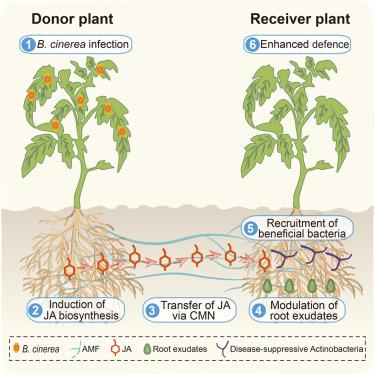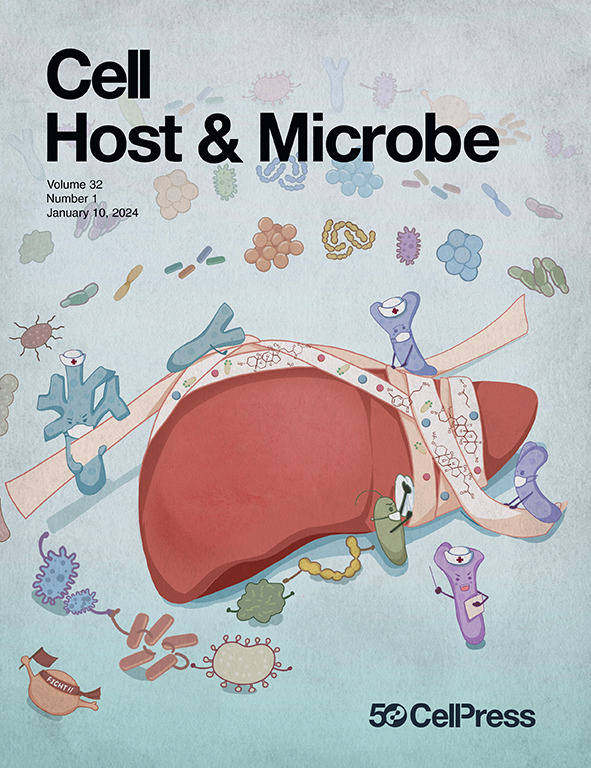Common mycorrhizal networks facilitate plant disease resistance by altering rhizosphere microbiome assembly
IF 18.7
1区 医学
Q1 MICROBIOLOGY
引用次数: 0
Abstract
Arbuscular mycorrhizal fungi can interconnect the roots of individual plants by forming common mycorrhizal networks (CMNs). These symbiotic structures can act as conduits for interplant communication. Despite their importance, the mechanisms of signal transfer via CMNs and their implications for plant community performance remain unknown. Here, we demonstrate that CMNs act as a pathway to elicit defense responses in healthy receiver plants connected to pathogen-infected donors. Specifically, we show that donor plants infected by the phytopathogen Botrytis cinerea transfer jasmonic acid via CMNs, which then act as a chemical signal in receiver plants. This signal transfer to receiver plants induces shifts in root exudates, promoting the recruitment of specific microbial taxa (Streptomyces and Actinoplanes) that are directly linked to the suppression of B. cinerea infection. Collectively, our study reveals that CMNs act as interplant chemical communication conduits, transferring signals that contribute to plant disease resistance via modulation of the rhizosphere microbiota.

常见的菌根网络通过改变根际微生物群的组合来促进植物抗病
丛枝菌根真菌可以通过形成共同的菌根网络(CMNs)将单个植物的根连接起来。这些共生结构可以作为植物间交流的管道。尽管它们很重要,但通过CMNs传递信号的机制及其对植物群落性能的影响尚不清楚。在这里,我们证明了CMNs作为一种途径,在与病原体感染的供体相连的健康受体植物中引发防御反应。具体来说,我们发现受植物病原体灰葡萄孢感染的供体植物通过CMNs传递茉莉酸,然后在受体植物中充当化学信号。这种向接收植物的信号传递诱导了根分泌物的变化,促进了特定微生物类群(链霉菌和放线素类)的招募,这些微生物类群与抑制灰葡萄球菌感染直接相关。总的来说,我们的研究表明,CMNs作为植物间的化学通讯管道,通过调节根际微生物群传递有助于植物抗病的信号。
本文章由计算机程序翻译,如有差异,请以英文原文为准。
求助全文
约1分钟内获得全文
求助全文
来源期刊

Cell host & microbe
生物-微生物学
CiteScore
45.10
自引率
1.70%
发文量
201
审稿时长
4-8 weeks
期刊介绍:
Cell Host & Microbe is a scientific journal that was launched in March 2007. The journal aims to provide a platform for scientists to exchange ideas and concepts related to the study of microbes and their interaction with host organisms at a molecular, cellular, and immune level. It publishes novel findings on a wide range of microorganisms including bacteria, fungi, parasites, and viruses. The journal focuses on the interface between the microbe and its host, whether the host is a vertebrate, invertebrate, or plant, and whether the microbe is pathogenic, non-pathogenic, or commensal. The integrated study of microbes and their interactions with each other, their host, and the cellular environment they inhabit is a unifying theme of the journal. The published work in Cell Host & Microbe is expected to be of exceptional significance within its field and also of interest to researchers in other areas. In addition to primary research articles, the journal features expert analysis, commentary, and reviews on current topics of interest in the field.
 求助内容:
求助内容: 应助结果提醒方式:
应助结果提醒方式:


